The weapon of information in the second Karabakh war. Yerevan's take
Information war during the second Karabakh
Many experts consider the second Karabakh war, which took place in the fall of 2020, to be unprecedented in terms of the scale of propaganda attacks in the information space that accompanied military actions.
Researchers in Yerevan and Baku analyzed the “information war” tools used by the “other side”. Below are the results of a study by an Armenian author in relation to the campaign that was waged by Azerbaijan.
Both publications use terminology and toponymy chosen by the authors.
The armed conflict in the Karabakh zone between the Azerbaijani and Armenian forces lasted 44 days, since September 27, 2020. During this time, at least eight thousand people died on both sides, the search for the missing continues at the time of publication of this article. On November 10, the Presidents of Azerbaijan and Russia and the Prime Minister of Armenia signed an agreement to end hostilities. The agreement included as the main points: the return to Azerbaijan of control over several regions adjacent to Nagorno-Karabakh; bringing Russian peacekeepers into the region; exchange of prisoners and return of refugees.
- The (dis)information war around Karabakh
- The fight against fake news
- The immortal parrot and all things impossible to divide: the Armenian-Azerbaijani musical legacy
Mass fake accounts of Azerbaijani users on social media
From the first day of the renewed conflict, martial law was introduced in Armenia, entailing a ban on unofficial or contradicting official sources of information about the hostilities.
The authorities in Azerbaijan chose a tougher method – Facebook, YouTube, WhatsApp, TikTok and other social media were blocked. But at the same time, a particularly fierce “information war”, parallel to the hostilities, was organized precisely on social media, especially on Twitter and Facebook.
On October 8, Facebook published a report on the removal of a large network from the Azerbaijani domain:
- 589 Facebook accounts
- 7906 Instagram pages
- 447 other accounts
The main function of these fake users, who are called “trolls”, was to leave comments under pro-Azerbaijani publications and disseminate information beneficial to the authorities.
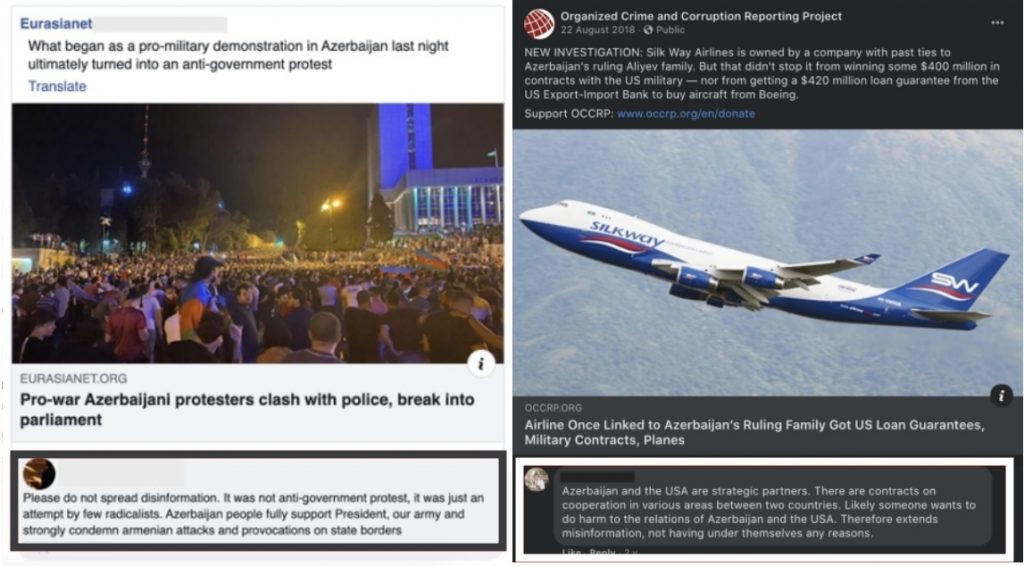
The study showed the relationship of “fake pages” with the youth wing of the New Azerbaijan Party.
Another study by DFRLab found that a similar toolkit was used on Twitter as well. Mass messages and reposts supported the Azerbaijani side, but upon checking, it turned out that several dozen very active accounts performed the same actions: their biographical data practically coincided, and the images that appeared on their pages were identical.
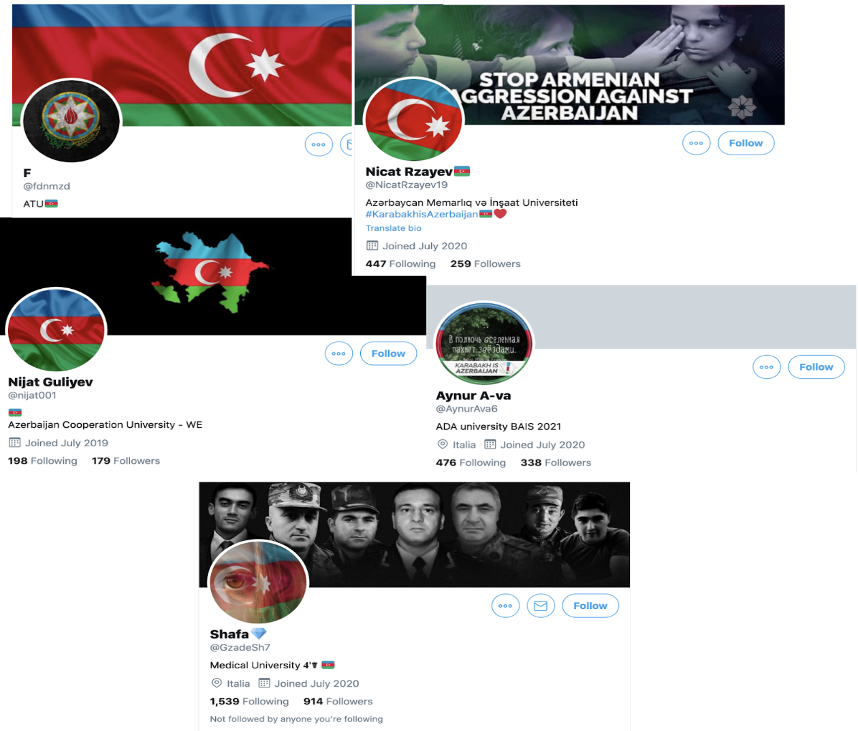
Kurdish, Syrian and Serbian militants who allegedly helped the Armenian military
Reports that Kurdish and Syrian militants were fighting on the Armenian side were widely spread from Azerbaijan during the 44-day war and also after it.
A few examples:
1.
Azpolitika.info published a message referring to the Turkish Haber7.com, in which it claimed that an Armenian battalion, formed in northern Syria, was sent to Artsakh [Karabakh] to participate in hostilities against Azerbaijan. No evidence has been provided for this.
2.
Several other publications – Day.az, oxu.az, baku.ws and others – published an article entitled “Syrian terrorists as part of the Armenian occupation forces.”
However, when examining the photographs published in the article as evidence, it turned out that they were in fact taken in Syria in 2019, during a meeting of the Nubar Ozanyan Armenian Brigade, which was held on the anniversary of the Armenian Genocide in Ottoman Turkey.
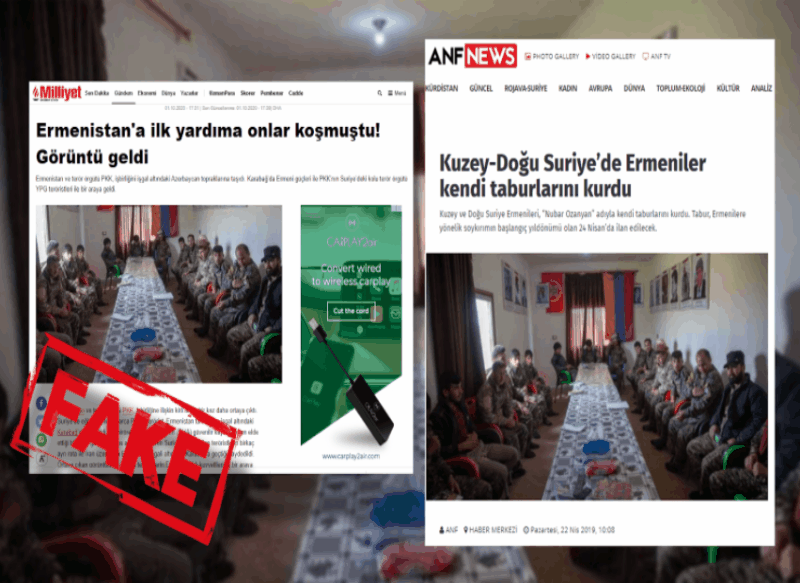
3.
The publication – Derindusunce.org, published on its Twitter microblog a photo of Serbian actor and producer Milos Bikovic with the caption: “Aleksa Djuric, a mercenary of Serbian origin, was spotted in Armenia”.
Kosovo war veteran Aleksa Djuric, now a Russian PMC, has been spotted in Armenia.His fate is not yet certain https://t.co/gJ88zRN2sC pic.twitter.com/wZsDRwSoTS
— ZOKA (@200_zoka) September 28, 2020
In reality, the Serbian actor was photographed on the set of the film “Kosare”.
Bikovich personally reacted to this misinformation by joking on Twitter: “Sometimes I put on a uniform between filming and advertising and rush to establish peace where it is needed.”
4.
The Turkish service CNN (CNN TÜRK) prepared an 8-minute video about the militants of the Kurdistan Workers’ Party, which is recognized as a terrorist organization in Turkey and many other countries, as well as the European Union. The report said that the militants fought on the side of Artsakh. The report included footage of alleged PKK militants fighting alongside the Armenian “ASALA” (an Armenian paramilitary group created in the mid-1970s, which stated its goal of forcing the Turkish government to publicly admit responsibility for the deaths of 1.5 million Armenians in Ottoman Turkey in 1915-1916).
In fact, the news agency confused the flag of the Colombian National Army (FARC) with the Armenian tricolor, and the photo itself was taken back in 2014.

5.
Telegram channels Günaz TV and Sepahcybery, and various Azerbaijani media published a video with the participation of the military, which also said that Armenia had attracted terrorist militants of the Kurdistan Workers’ Party to participate in the hostilities.
As proof, a video was shown where in fact a volunteer detachment of the Yezidi community of Armenia was shown. Moreover, the same video was posted on the Pers tna Yezidi channel on Instagram. The video was recorded in the Yezidi language, the volunteers say the following: “Who are we? Yezidis! “
“Mass evacuation” of the population of Artsakh
Three days before the outbreak of hostilities, on September 24, 2020, news about the mass evacuation of the population of Artsakh began to spread in the Azerbaijani media.
Through various social networks (Telegram, Viber, WhatsApp), the residents of Nagorno-Karabakh and Armenia were sent a photo of a certain document, which said: “The Ministry of Defense warns the residents of Artsakh about the need to be ready for an emergency evacuation.”
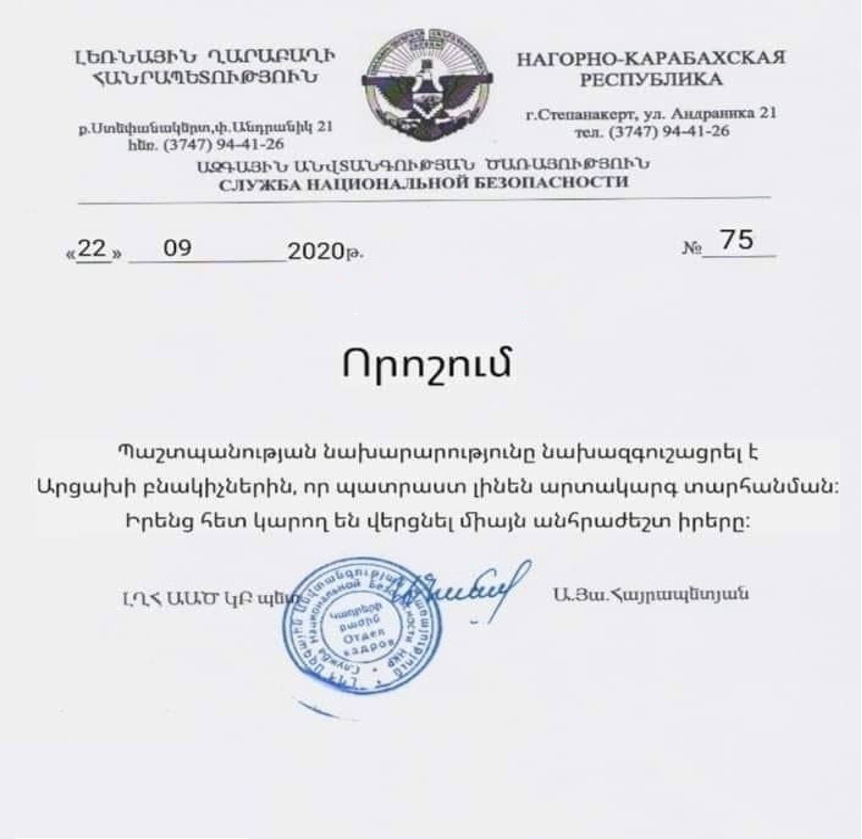
Information security expert Samvel Martirosyan was the first to point out that the document was a forgery. Later, an official refutation of the document followed.
The Azerbaijani media, however, continued to publish reports of the mass evacuation. On October 1, Trend.az published a video without sound showing an endless column of cars. Attached to this video was a comment stating that it was the Armenians who were leaving Nagorno-Karabakh.
Information verification platform infocheck.am revealed that the video was first published on the Armenian Instagram domain, on the aratta_armenia page. The video material actually depicted a convoy with Armenian volunteers on their way to Nagorno-Karabakh. Trend.az simply fabricated a video taken from the Armenian domain and presented it in a completely different context.
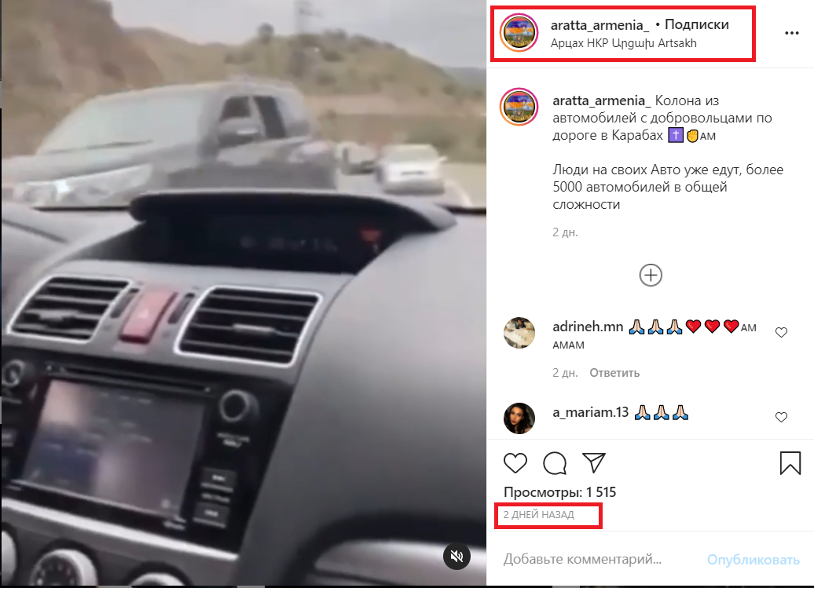
Exaggerated data on the losses of the Armenian army
During the 44-day war, the Azerbaijani media published many false reports about the deaths of Armenian soldiers, generals, and members of the political leadership. Also, journalists and officials made statements about large-scale losses on the Armenian side.
1.
On October 28, Azerbaijani President Ilham Aliyev said in an interview with Interfax that the combat losses of the Armenian side amounted to about 5 thousand people.
On the same day, one of the Azerbaijani TV channels reported that the hackers had published real data on the losses of the Armenian side. More than 5000 Armenian names with dates of birth were presented as evidence.
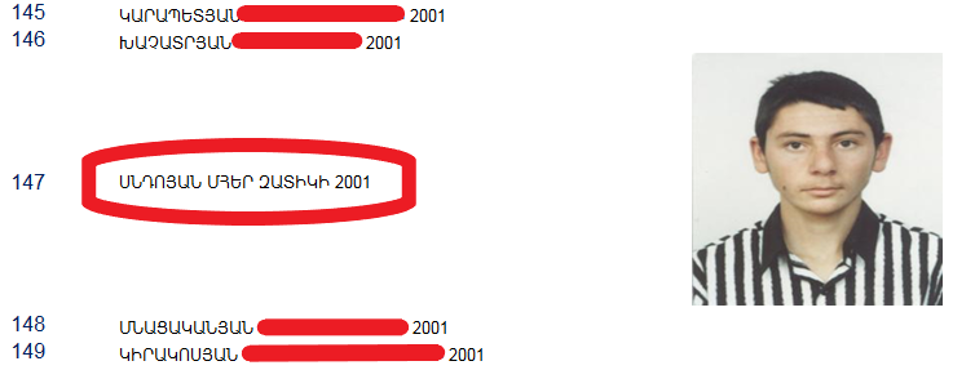
The list included the names of the victims, already published by the Armenian side. However, most of the names given there had nothing to do with the real victims of the war.
For example, 26-year-old Mher Andoyan found his name and photo in one of the Azerbaijani media. In a conversation with Fip.am, Andoyan confirmed that in the photo he really is, but at the age of 15-16, since the Azerbaijani hackers incorrectly indicated his date of birth.
A detailed study of the list showed that this case is far from the only one – thousands of Armenian names somehow ended up at the disposal of Azerbaijani hackers. In particular, in these lists the name of the BHC was repeated three times (the abbreviated name of the “Prosperous Armenia” party in Armenian). The non-existent name Erbek was mentioned 19 times (translated from Armenian “erbek” means “never”).

[A similar fake portal was created with the names of Azerbaijani dead soldiers, read about this in a study prepared in Baku]
2.
Azerbaijani Telegram channels, citing military sources, wrote that a bunker was destroyed, in which there were officers, generals and other high-ranking officials of the armed forces of Armenia.
Details were reported – that the fatal blow was inflicted by an Israeli-made Harop drone, and a photograph of the event was published.

In reality, the published photograph is at least four years old. She appeared on the Internet back in 2016.
3.
On October 29, the Azerbaijani Defense Ministry announced the destruction of two Su-25 aircraft belonging to the Armenian Armed Forces. Later, a photo of the downed plane appeared on social networks, which they tried to pass off as an Armenian Su-25.
However, it turned out that the photo was taken in Syria, near the city of Saraqib. The image, which was first published on March 1, 2020, shows a Turkish drone.

4.
Separate mention is made of the “news” about the deaths of military men and politicians. From the very beginning of the war, there was talk about the injury and death of Artsakh President Arayik Harutyunyan. Even various Russian media wrote about this with reference to Azerbaijani sources. This misinformation was spread so often that it sometimes coincided with live broadcasts with the participation of Arayik Harutyunyan.
On September 28, news appeared about the death of Lieutenant Colonel Lernik Babayan. Soon Babayan himself reacted to the news of his death, noting that he was alive and well.
Misinformation also included reports of the wounding of the current Deputy Prime Minister Tigran Avinyan, the second President of Armenia Robert Kocharian, the former Minister of Defense Seyran Ohanyan, and the assassination of the Commander of the Defense Army Jalal Harutyunyan.

Cyberattacks as a tool for spreading fakes
2020 was the most difficult year for Armenia in terms of the scale of cyber attacks – both during the second Karabakh war and during the aggravation on the Armenian-Azerbaijani border in July 2020.
According to experts, the number and quality of hacker attacks testified to the attraction of additional forces from Azerbaijan. The hackers targeted the state apparatus, the press, and the civilian population.
On October 10, an unprecedented cyberattack was carried out, during which Azerbaijani hackers hacked about 50 state websites.
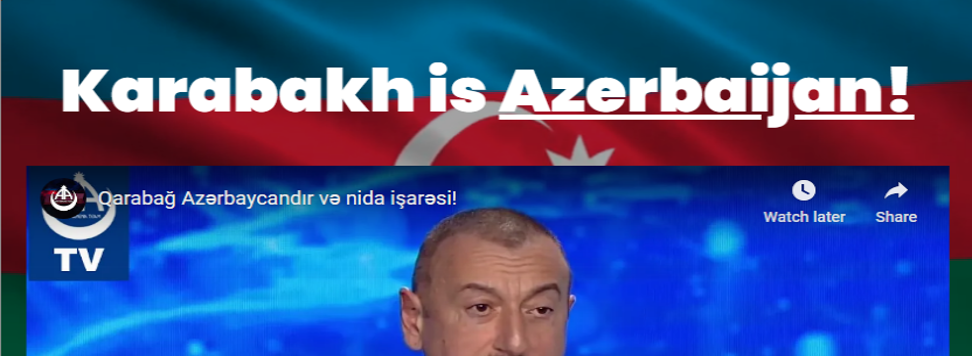
The media began to be subjected to large-scale (mainly DDoS) attacks, which continue to this day. The following news sites have been targeted by cyber attacks:
?1in.am ?a1plus.am ?armenpress.am ?armtimes.com ?blognews.am ?hetq.am ?mamul.am ?mediamax.am ?news.am ?zhamanak.com
Phishing attacks on users were also active. Misinformation and panic-spreading news spread either through hacked pages or through fake websites that were created from copies of well-known news outlets.


















